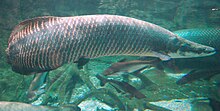
Back أربيمة Arabic Arapaima CEB Arapaima German Arapaima Spanish Arapaima French Arapaima Galician ארפאימה (סוג) HE Arapaima (halnem) Hungarian Arapaima ID Arapaima Italian
| Arapaima | |
|---|---|

| |
| Arapaima gigas at Beijing Aquarium | |
| Scientific classification | |
| Domain: | Eukaryota |
| Kingdom: | Animalia |
| Phylum: | Chordata |
| Class: | Actinopterygii |
| Order: | Osteoglossiformes |
| Family: | Osteoglossidae |
| Subfamily: | Arapaiminae |
| Genus: | Arapaima J. P. Müller, 1843 |
| Type species | |
| Sudis gigas Schinz, 1822
| |
| Species | |
|
4-5, see text | |
| Synonyms | |
| |
The arapaima, pirarucu, or paiche is any large species of bonytongue in the genus Arapaima native to the Amazon and Essequibo basins of South America. Arapaima is the type genus of the subfamily Arapaiminae within the family Osteoglossidae.[1][2][3] They are among the world's largest freshwater fish, reaching as much as 3 m (9.8 ft) in length.[2] They are an important food fish. They have declined in the native range due to overfishing and habitat loss. In contrast, arapaima have been introduced to several tropical regions outside the native range (within South America and elsewhere), where they are sometimes considered invasive species.[4] In Kerala, India, arapaima escaped from aquaculture ponds after floods in 2018.[5] Its Portuguese name, pirarucu, derives from the Tupi language words pira and urucum, meaning "red fish".[6]
Arapaima was traditionally regarded as a monotypic genus, but later, several species were distinguished.[3][7][8] As a consequence of this taxonomic confusion, most earlier studies were done using the name A. gigas, but this species is only known from old museum specimens and the exact native range is unclear. The regularly seen and studied species is A. arapaima,[7][8][9] although a small number of A. leptosoma also have been recorded in the aquarium trade.[10] The remaining species are virtually unknown: A. agassizii from old detailed drawings (the type specimen itself was lost during World War II bombings) and A. mapae from the type specimen.[3][7][8]
- ^ Hilton, E. J.; Lavoué, S. (2018). "A review of the systematic biology of fossil and living bony-tongue fishes, Osteoglossomorpha (Actinopterygii: Teleostei)". Neotropical Ichthyology. 16 (3). doi:10.1590/1982-0224-20180031. S2CID 92396368.
- ^ a b Cite error: The named reference
FishBasewas invoked but never defined (see the help page). - ^ a b c Castello, L.; and Stewart, D.J (2008). Assessing CITES non-detriment findings procedures for Arapaima in Brazil. NDF Workshop case studies (Mexico 2008), WG 8 – Fishes, Case study 1
- ^ Miranda-Chumacero, G.; Wallace, R.; Calderón, H.; Calderón, G.; Willink, P.; Guerrero, M.; Siles, T.M.; Lara, K.; and Chuqui, D. (2012). Distribution of arapaima (Arapaima gigas) (Pisces: Arapaimatidae) in Bolivia: implications in the control and management of a non-native population. BioInvasions Records 1(2): 129–138
- ^ Kumar, Biju; Raj, Smrithy; C.P., Arjun; Katwate, Unmesh; Raghavan, Rajeev (22 May 2019). "Jurassic invaders: flood-associated occurrence of arapaima and alligator gar in the rivers of Kerala" (PDF). Current Science. 116 (10). Current Science Association + Indian Academy of Sciences: 1628–1630. ResearchGate. CABD 20210033477.
- ^ "Arapaima". Smithsonian's National Zoo & Conservation Biology Institute.
- ^ a b c Stewart, D.J. (2013). A New Species of Arapaima (Osteoglossomorpha: Osteoglossidae) from the Solimões River, Amazonas State, Brazil. Copeia, 2013 (3): 470-476.
- ^ a b c Stewart, D. J. (2013). Redescription of Arapaima agassizii (Valenciennes), a rare fish from Brazil (Osteoglossomorpha, Osteoglossidae). Copeia, 2013: 38-51
- ^ Dawes, J: Arapaima Re-classification and the Trade. Archived December 22, 2014, at the Wayback Machine Retrieved 24 May 2014
- ^ Howard, B.C. (13 October 2013). New Species of Giant Air-Breathing Fish: Freshwater Species of the Week. National Geographic. Retrieved 24 May 2014
© MMXXIII Rich X Search. We shall prevail. All rights reserved. Rich X Search